IT ALL COMES DOWN TO THE GUIDING
Short read: Madame Jenever to Mother’s Ruin
Medium read: In 1751 William Hogarth publicised two new works: ‘…Two large Prints design’d and etch’d by Mr Hogarth, call’d BEER STREET and GIN LANE…To be had at the Golden Head in Leicester Fields, where may be had all his other works.’
Our tour follows the events and moral panic that led to the creation of the more infamous Gin Lane. It starts at the site of William Hogarth’s home and painting room near Leicester Square, where the artist sold the prints at a low price, the better to spread the message of the drink’s ‘horrid effects’. From there, we explore the streets of Covent Garden, where gin had become the preferred lubricant for frequenters of chandlers’ shops, stews and taverns. On our walk we examine the role of the great and the good, most notably Henry Fielding and his brother John, in trying to regulate the once-modish spirit. On our way to discovering the site of the infamous rookeries of St Giles, we also explore the argument that laws passed to suppress gin drinking among the poor were really prompted by widespread fears about what came to be known as foetal alcohol syndrome, or whether the Gin Craze created a panic among the ruling classes for more sinister reasons.
Long read: Gin, aka Madam Juniper, Mother Jenever, Mother’s Ruin, or ‘cursed Fiend…that on the Vitals preys’ went from being a fashionable, patriotic juniper-infused tipple to the curse of London’s miserable poor over the course of three decades in the early eighteenth century. This period became known as the Gin Craze. At its height, gin’s popularity was seen as the root of all ills: from fecklessness to infanticide.
At the heart of the moral panic surrounding the excessive drinking of gin stands one unforgettable image: Gin Lane, by William Hogarth.
Ronnie’s tour follows the events that led to what was seen as an epidemic of spirit drinking, and how William Hogarth’s talent for social commentary led him to step right into the drunken fray by creating Gin Lane, and its companion piece, Beer Street.
We start at Leicester Square, and the site of Hogarth’s home and studio from 1733, and move through the streets of Covent Garden following the artist’s fortunes, and the streets and alleyways where, at the height of the Gin Craze, every chandler’s shop would sell you a measure of gin for a penny. On our way, we’ll discover how the spirit came to be deplored among the great and the good, and discuss the frantic attempts to regulate its production. As our tour homes in on the infamous rookeries of St Giles, we also explore the argument that attempts to suppress gin drinking among the poor were really prompted by widespread fears about what came to be known as foetal alcohol syndrome,or whether the Gin Craze created hysteria among the ruling classes for more sinister reasons.
‘What must become of an infant, who is conceived in gin, with the poisonous distillations of which it is nourished, both in the womb and at the breast?’ (Sir John Fielding)
‘Poverty misery and ruin are to be seen Distress even unto madness and death, and not a house in tolerable condition but Pawnbrokers and the Gin shop.’ (William Hogarth)

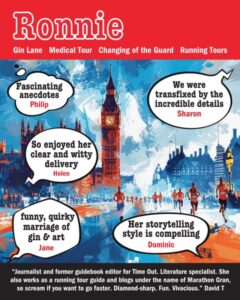
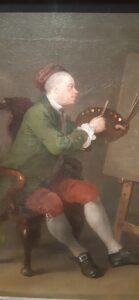
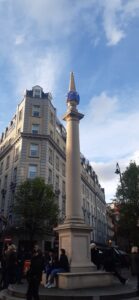
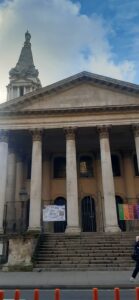
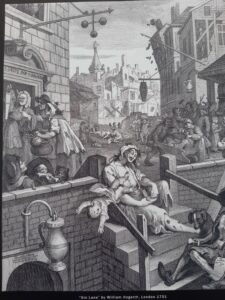
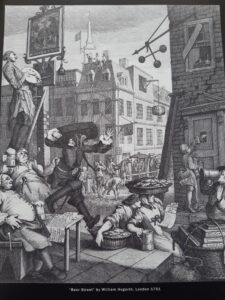
PETER MCDONALD –
I have admired Hogarths works for years and this walk made it all come to life. Well done Ronnie
Richard S –
Nicely delivered and nicely paced. Ronnie held our attention from start to finish. The two strands of Hogarth, and the 18th century gin boom and bust were nicely interwoven in a story that never strayed far from the human suffering that existed at the time. Several nice poetic interludes added colour to the afternoon.
Fiona Cumberpatch –
Ronnie evokes Hogarth, his work and his world so well on this tour which wends its way from the National Portrait Gallery through the streets of Covent Garden and Bloomsbury. She reveals fascinating biographical details about the artist and his circle, and a vivid social history of the time including the rise of the gin trade and its devastating effects on the poor. Witty and well researched, the tour made me look at familiar landmarks in a different light.
Sally –
A wonderfully informative and entertaining walk with Ronnie. Brought alive the period, the awful living conditions of the poor and the unjust way they were treated. This was my first London Walk and I will definitely be doing more.
Debbie Walker –
Love a London Walk and this one did not disappoint. Really interesting to learn another side of the ‘Gin Lane’ story, a very enjoyable couple of hours with Ronnie.
Jane –
An interesting new tour. A part of London’s history I was not familiar with. Ronnie can recite great poems and delightfully entertaining.
Christoph Karner –
A very good and highly interesting walk and very well presented.
Ronnie really makes us understand what happened in the first halve of the 18th century, brings art, politics, life, disease, geographie of this part of London and much more to life in front of our eyes.
The walk can be highly recommended.